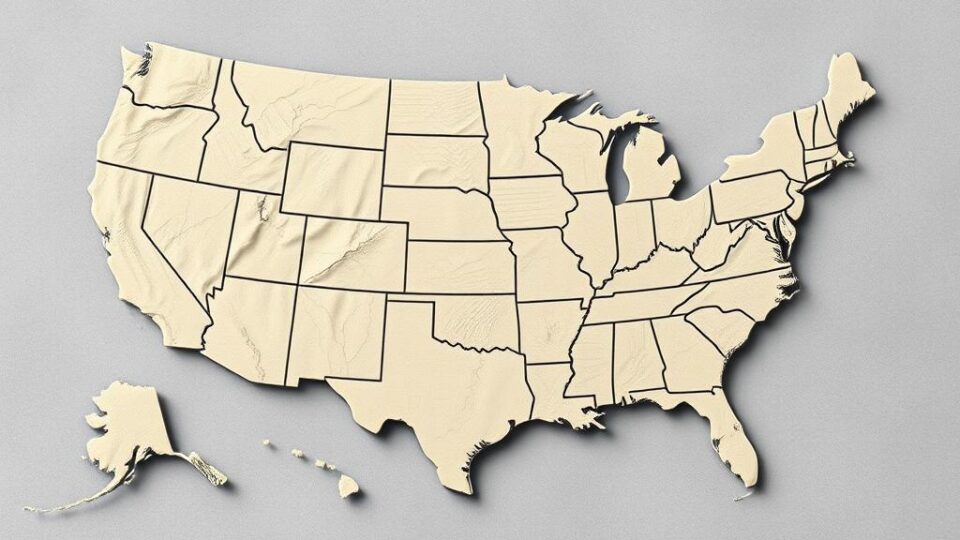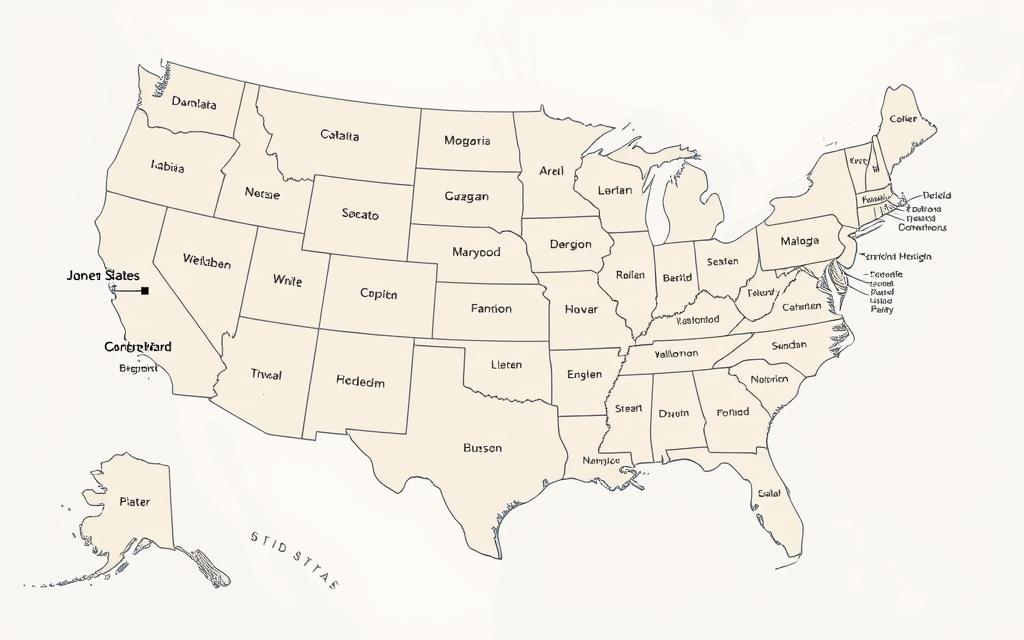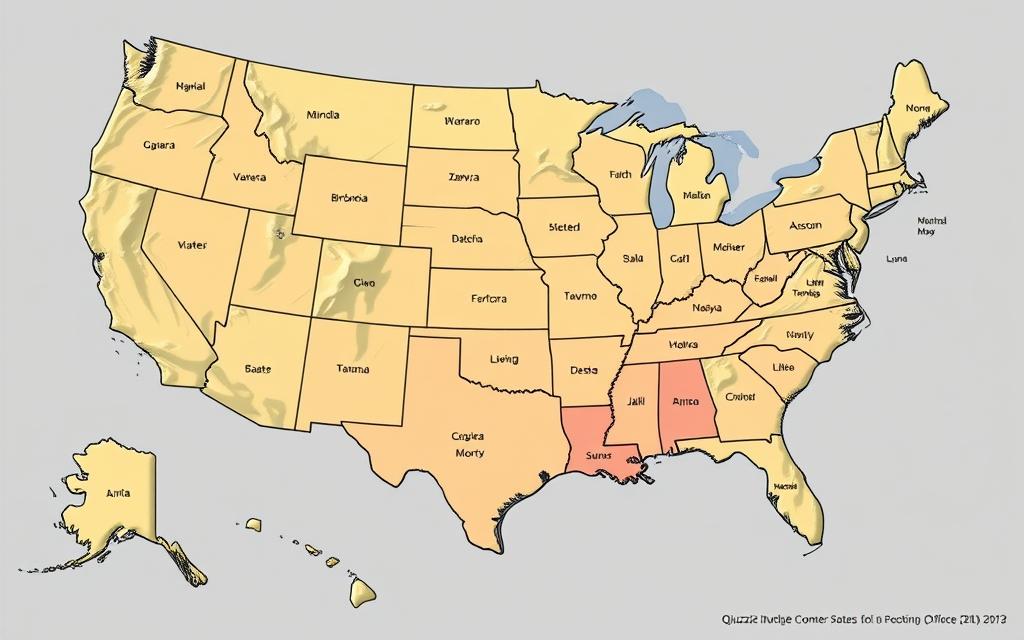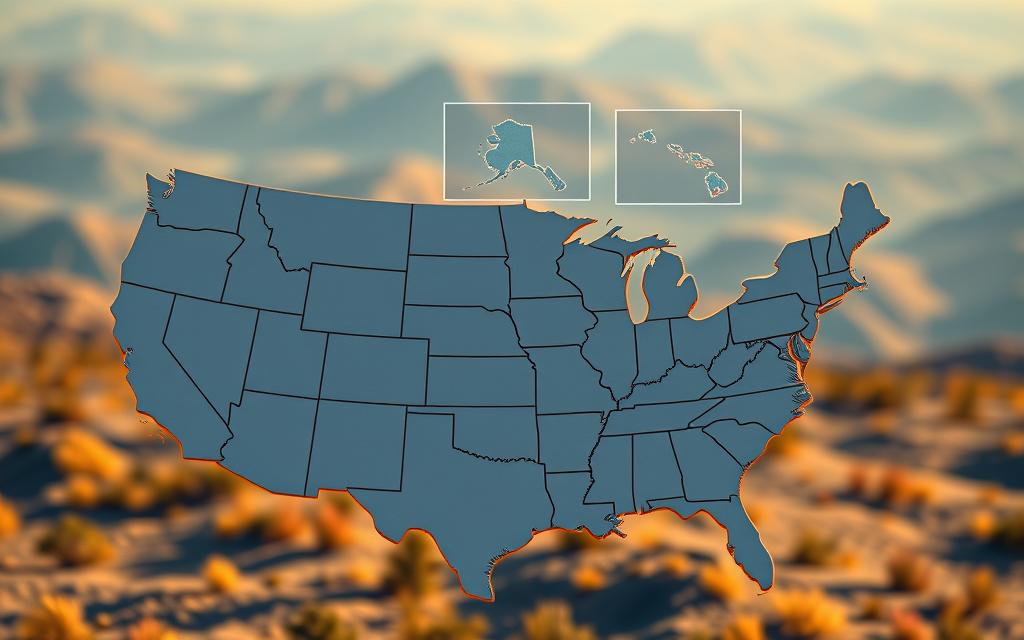
Exploring the US states count shows a rich mix of geography and culture. Knowing how many states are in the US helps us understand the country’s complex makeup. With 50 states from Alaska to Florida, each adds its own special touch to the nation.
This guide will take you on a journey through America’s states. You’ll learn about their history, geography, and culture. Discover the amazing diversity that makes the United States so unique.
Key Takeaways
- The United States comprises exactly 50 states
- States range from tiny Rhode Island to massive Alaska
- Each state has unique cultural and geographic characteristics
- States are divided into four primary regions: Northeast, Midwest, South, and West
- California remains the most populated state in the country
How Many States Are in the U.S.?
There are 50 states in America. This number shows the country’s growth and expansion. It’s a journey of territorial growth.
The number of states has changed over time. The country started with 13 colonies. These colonies became the first states after the American Revolution. The 19th and early 20th centuries saw the country grow even more.
The Path to 50 States
The journey to 50 states had many important moments:
- The first states were ratified in 1787
- Territorial acquisitions expanded the nation’s borders
- Alaska became the 49th state in 1959
- Hawaii followed as the 50th state in the same year
Interesting State Facts
Here are some interesting facts about the states:
- The mainland USA has 48 contiguous states
- Alaska and Hawaii are non-contiguous states
- California is the most populous state
- Rhode Island is the smallest state, covering just 1,545 square miles
“From 13 colonies to 50 states, the United States represents a remarkable story of growth and unity.” – American Historian
The number 50 is more than just a count. It shows the diverse and complex tapestry of American geography, culture, and history.
The States and Their Capitals
Knowing state capitals is key to understanding the 50 states of the United States. Each state has a capital city that is the heart of government.

State capitals are interesting places of local government. They might not be the biggest cities, but they are vital for state administration and politics.
Overview of State Capitals
Every state has its own capital city, each with its own special features. These cities are the political centers of their states. They host state legislatures, governor’s offices, and other important government buildings.
Notable State Capitals
- Austin, Texas: A lively capital with a 2021 population of 964,177
- Sacramento, California: The home of state government with 525,041 people
- Atlanta, Georgia: A big city capital with 496,461 residents
State vs. Capital Trivia
Interesting facts about state capitals show us interesting things about American government:
| Smallest Capital | Largest Capital | Unique Fact |
|---|---|---|
| Montpelier, Vermont (8,002 residents) | Phoenix, Arizona (1,624,569 residents) | Not all capitals are the most populous city in their state |
Exploring state capitals shows us the diverse and complex political world of the United States. It highlights how each state keeps its own unique government identity.
Regional Breakdown of the States
The United States is a vast landscape with diverse regions. Each region has its own culture, geography, and identity. Knowing the US state list helps us see the rich tapestry of American geography.

The U.S. Census Bureau recognizes four main regions. These are divided into nine distinct divisions. This breakdown helps us understand the US territory count and its geographical makeup.
Northeast Region
The Northeast has two key divisions:
- New England: Connecticut, Maine, Massachusetts, New Hampshire, Rhode Island, Vermont
- Middle Atlantic: New Jersey, New York, Pennsylvania
Midwest Region
The Midwest is the heart of America, divided into two regions:
- East North Central: Illinois, Indiana, Michigan, Ohio, Wisconsin
- West North Central: Iowa, Kansas, Minnesota, Missouri, Nebraska, North Dakota, South Dakota
Southern Region
The South has three diverse divisions:
- South Atlantic: Florida, Georgia, North Carolina, South Carolina, Virginia, Maryland, Delaware, Washington D.C.
- East South Central: Alabama, Kentucky, Mississippi, Tennessee
- West South Central: Arkansas, Louisiana, Oklahoma, Texas
Western Region
The West is divided into two dynamic regions:
- Mountain Division: Arizona, Colorado, Idaho, Montana, Nevada, New Mexico, Utah, Wyoming
- Pacific Division: Alaska, California, Hawaii, Oregon, Washington
Each region gives us a unique view of America’s geography and culture. It shows the nation’s amazing diversity in its 50 states.
Largest and Smallest States
Exploring the United States shows amazing size differences. These differences highlight the country’s vast geographic diversity. Each state, big or small, adds to the country’s rich tapestry.

The size of the 50 states in the US is truly fascinating. Let’s look at the extremes of state sizes:
Alaska: The Colossal Northern Giant
Alaska is a true marvel. If Alaska were cut in half, each half would still be bigger than Texas. It covers an area of 665,384 square miles, making it much larger than other states.
- Total area: 665,384 square miles
- Land area: 570,641 square miles
- Water area: 94,743 square miles
Rhode Island: The Compact Coastal State
Rhode Island is the smallest state. Despite its small size, it has a lot of charm and history. It covers just 1,545 square miles.
- Total area: 1,545 square miles
- Land area: 1,034 square miles
- Water area: 511 square miles
Size Comparison Across States
“The beauty of the United States lies not just in its size, but in its diversity.” – Anonymous
| Rank | State | Total Area (sq mi) | Land Area (sq mi) |
|---|---|---|---|
| 1 | Alaska | 665,384 | 570,641 |
| 2 | Texas | 268,596 | 261,232 |
| 49 | Rhode Island | 1,545 | 1,034 |
| 50 | Delaware | 2,489 | 1,949 |
Knowing the size differences among states shows the country’s geographic complexity. Each state, big or small, adds its own unique touch to the national landscape.
U.S. Territories and Their Relationship to States
The United States is more than just 50 states. It also has several territories that add to its complexity. These territories play a key role in American governance, even though they are not states.
Today, the U.S. has 14 territories, with five inhabited. These places have special ties to the federal government. Each territory faces its own set of challenges and has its own unique features.
Inhabited Territories Overview
The five inhabited U.S. territories are:
- Puerto Rico
- Guam
- U.S. Virgin Islands
- Northern Mariana Islands
- American Samoa
Status of Puerto Rico and Guam
Puerto Rico is a standout territory. It has over 3.2 million residents, making it more populous than 21 states. Guam, with about 153,836 people, covers 543 square kilometers.
Comparing Territories to States
Territories have less power than states. They can’t vote in presidential elections and have non-voting reps in Congress. Their residents are U.S. citizens but face different rules than state residents.
Each territory deals with its own economic and social issues. Poverty rates and development levels vary, showing the different experiences in these American areas.
State Symbols and Emblems
Every state in America has its own story, told through its symbols. These symbols show the rich culture and natural beauty of each state. They include flowers, birds, and more, capturing the local identity and pride.
Looking into state symbols gives us a peek into the unique qualities of each state. Each symbol holds something special, weaving together a rich tapestry of national identity. The tradition of state symbols started after the 1893 World’s Fair in Chicago, inspiring a movement of cultural representation.
Nature’s Representatives: State Flowers and Trees
States highlight their natural beauty with official flowers and trees. Some notable examples include:
- California’s golden poppy
- Hawaii’s vibrant yellow hibiscus
- Vermont’s beautiful sugar maple tree
Feathered Emblems: State Birds
State birds represent local wildlife and character. Ornithological pride is widespread across the United States.
| State | State Bird | Significance |
|---|---|---|
| Alaska | Willow Ptarmigan | Survives harsh Arctic conditions |
| California | California Quail | Native ground-dwelling bird |
| Texas | Mockingbird | Known for complex songs |
Unique State Symbols
Some states have unique emblems that show off local culture and creativity. New Mexico, for example, has an official state guitar. This highlights the diversity of state symbols across the nation.
“Every symbol tells a story of local pride and cultural identity.” – State Symbols Historian
Understanding State Borders
Exploring the number of states in the US requires knowing their borders. The 50 states have complex boundaries shaped by geography and history. These boundaries fascinate many.
State borders are more than lines on a map. They come from historical events like land purchases and surveys. Natural features also play a role.
Historical Border Transformations
State boundaries have changed a lot over time. These changes were influenced by:
- Territorial acquisitions
- Geological surveys
- Political negotiations
- Native American land agreements
Border Definition Techniques
States use advanced methods to define their borders:
- Geographical Features: Rivers, mountains, and coastlines
- Astronomical Surveying: Using latitude and longitude
- Geodetic Measurements: Detailed mathematical calculations
Notable Border Disputes
Some state borders have led to interesting legal battles. These disputes often involve historical claims and legal talks.
| State Pair | Dispute Type | Resolution Method |
|---|---|---|
| Ohio-Michigan | Toledo Strip Conflict | Congressional Mediation |
| Kansas-Nebraska | Border Alignment | Surveyed Boundary |
| Texas-New Mexico | Territorial Boundaries | Supreme Court Settlement |
Learning about these border details shows the rich geography of the US. It highlights the uniqueness of its 50 states.
Cultural Diversity Across the States
The United States is a vibrant tapestry of cultural diversity. Each state adds its own traditions and views to the national identity. From big cities to small towns, the US offers a wide range of cultural experiences.
Regional Cultural Variations
Cultural differences show up in different parts of the country. The demographic landscape is full of interesting patterns:
- Western states like California and Texas have a lot of multicultural people
- Midwestern states stick to traditional cultures
- Southeastern states mix old Southern traditions with new ones
- Northeastern states show a mix of immigrant backgrounds
Demographic Insights
| Demographic Group | Percentage |
|---|---|
| Non-Hispanic White | 60.1% |
| Hispanic and Latino | 18.5% |
| Black or African American | 13.4% |
| Asian | 5.9% |
The Melting Pot Concept
America’s cultural diversity keeps changing. By 2044, the United States will no longer have a single ethnic majority. This change shows how the nation’s social fabric is always evolving, with different cultures mixing to create new experiences.
Cultural Perspectives
Public views on cultural diversity are complex:
- 57% see racial and ethnic diversity as positive
- 64% think diversity makes U.S. culture better
- 75% support diversity in the workplace
Resources for Learning About States
Exploring the 50 states of the US is an exciting journey. You can learn about how many states are in the US or dive into state trivia. Many resources are available to help you learn more. You’ll find interactive tools and guides that make learning fun.
Digital platforms are great for learning about the US states. Websites like National Geographic Kids and History.com have interactive maps and detailed state profiles. They make learning about states fun and informative. Apps like Stack the States and Seterra Geography Challenge turn learning into games.
If you prefer books and documentaries, there are many options. Publishers like National Geographic and Smithsonian have guides on state facts and history. Local libraries and bookstores also have resources to help you understand each state’s unique identity.
Interactive museums, state visitor centers, and online platforms offer more learning opportunities. Whether you’re a student, teacher, or just curious, these resources make learning about states fun. With the right tools, exploring the US states can be both educational and enjoyable.








